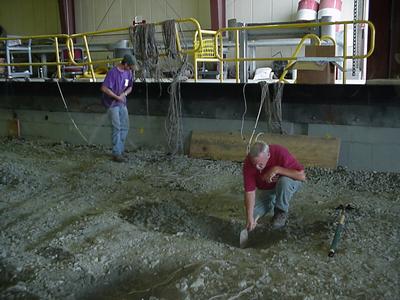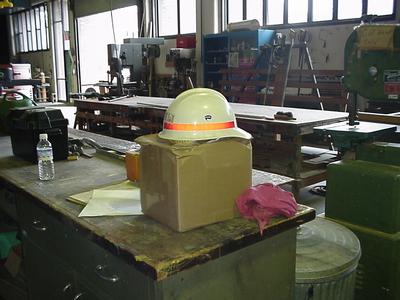8 August, 2001
BRRRR! A Visit to the CRREL (Cold Regions Research and Engineering Lab)
Before visiting the Cold Regions Research and Engineering Lab
(CRREL) in Hanover, New Hampshire, I had conjured up pictures in my mind
of icebergs and freezing temperatures. Although the research that is
conducted there is all connected to cold regions and reactions of
materials to freezing temperatures, our visit mainly took place outside
in 90+ temperatures. It was anything but cold!
Ammonia burned our noses as we entered our first lab and jerked
us to attention. Leonard Zabilanski, General Engineer, explained that it
is used as a refrigerant because it is the safest. Tongue-in-cheek, he
said, "It's a wake-up call. If the cold doesn't get you, the ammonia
will!" He explained that the work done in his lab is involved with ice
testing. Frazil ice and its effect on the river locks are studied.
Scientists are trying to find ways to keep winter flooding from
happening when frazil ice blocks river systems. They study what happens
in the field and numerical models are generated. Then models are built
and tested in the lab and the numerical data is compared. We walked
along a model of a lock system and jumped the "river". The model created
a way to divert frazil ice away from the locks and allow ships to pass
with no ice jams. Later the models are built to scale and tested in the
environment. Many studies are conducted in this parcticular lab that
concern the effect of frazil ice on fish, the development of ice
breaking ships, controlling ice jam floods, and developing ice control
structures.
Being a driver from the Chicago area, I was parcticularly
interested in the testing being done on road building materials. Winter
plays havoc with cars by making huge potholes in northern highways. A
huge garage-like building at the CRREL site houses the basins where
these tests are conducted. Roads are built in the basins with sensors
under the gravel. Asphalt of different materials is paved on top, and
in some tests the roads are taken through many freeze/thaw cycles. One
road basin is testing two materials: a geo-grid material made of plastic
and a geo-textile made of carpet material. A huge accelerated load car
runs tires over the strips at such an incredible rate that twenty years
of data can be generated in just two weeks. When the tests are finished,
huge bulldozers dig up the roads, and new tests are set up in the
basins. Our guide told us that the preliminaryresults from these tests
are very promising, so I am hoping to see improved roads near my house
soon!
After hiking around the thirty acres of CRREL property in 90
degree temperatures, we found shivering relief in the minus twenty-five
degree cold room of the lab. It provided quick relief by cooling our
overheated skin, and fogged our glasses, momentarily blinding those of
us who needed them. It was parcticularly interesting to see Deb Meese's
frozen samples taken from Greenland. Deb, a principal investigator
working with CRREL and the TEA program, had shared her work and
discoveries in the ice cores with us yesterday.

2. Civilian workers build test roads in CRREL lab basins. Here a worker is burying sensors under the gravel using a trowel, while another worker organizes the sensor wires.

3. Deb Meese stored her Greenland ice core samples in the cold room at CRREL.

1. Hard hats must be part of a scientist's equipment when building models in a lab, which is similar to a construction site. Models are used to test variables before trying expensive solutions in the real environment.
Contact the TEA in the field at
.
If you cannot connect through your browser, copy the
TEA's e-mail address in the "To:" line of
your favorite e-mail package.
|
